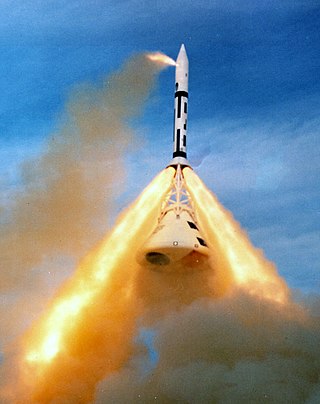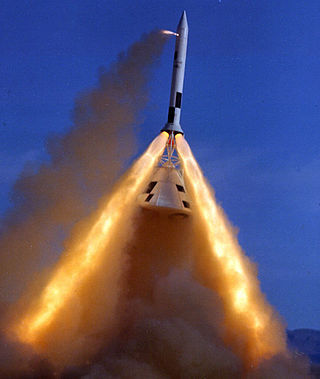Flight
The test vehicle was launched on May 19, 1965, at 6:01:04 a.m. M.S.T. (13:01:04 UTC). Within 2.5 seconds after lift-off, a launch malfunction caused the vehicle to go out of control. The launch vehicle entered into a roll which caused it to break up before second-stage ignition, and a low-altitude abort was initiated instead of the planned high-altitude abort. The launch escape system canard surfaces deployed and survived the severe environment. The high roll rates (approximately 260 degrees per second at the time of canard deployment) induced by the launch vehicle malfunction stabilized the launch escape vehicle in a tower-forward attitude, which overcame the destabilizing effect of the canards. Post-flight simulations verified the ineffectiveness of the canards at the high roll rate, but showed that canards would be effective at the 20 degree per second roll rate limit of the Saturn emergency detection system.
All spacecraft systems operated satisfactorily. The command module forward heat shield was protected by the hard portion of the boost protective cover and was jettisoned satisfactorily in an apex-forward attitude at low altitude. The soft portion of the boost protective cover remained intact until tower jettison. At tower jettison, part of the cover stayed with the command module for a short time although the rest of the cover moved away with the tower. The hard portion of the boost protective cover remained intact until ground impact. Both drogue parachutes inflated, even under the severe conditions that existed; that is, command module apex forward and rolling. The command module was effectively stabilized and oriented for deployment of the main parachutes.
Because of the early launch vehicle breakup, the desired altitude of 120,000 feet (36.6 km) was not achieved. However, the spacecraft did demonstrate a successful low-altitude abort at 12,400 ft (3.8 km) from a rapidly rolling (approximately 335 degrees per second) launch vehicle. The Mach number, dynamic pressure, and altitude at the time of abort were similar to Saturn IB or Saturn V launch trajectory conditions.

AS-201, flown February 26, 1966, was the first uncrewed test flight of an entire production Block I Apollo command and service module and the Saturn IB launch vehicle. The spacecraft consisted of the second Block I command module and the first Block I service module. The suborbital flight was a partially successful demonstration of the service propulsion system and the reaction control systems of both modules, and successfully demonstrated the capability of the command module's heat shield to survive re-entry from low Earth orbit.

Pad Abort Test 1 was the first abort test of the Apollo spacecraft on November 7, 1963.

AS-101 was the sixth flight of the Saturn I launch vehicle, which carried the first boilerplate Apollo spacecraft into low Earth orbit. The test took place on May 28, 1964, lasting for four orbits. The spacecraft and its upper stage completed a total of 54 orbits before reentering the atmosphere and crashing in the Pacific Ocean on June 1, 1964.

AS-102 was the seventh flight of the Saturn I launch vehicle, which carried the boilerplate Apollo spacecraft BP-15 into low Earth orbit. The test took place on September 18, 1964, lasting for five orbits. The spacecraft and its upper stage completed 59 orbits before reentering the atmosphere and crashing in the Indian Ocean on September 22, 1964.

The Apollo spacecraft was composed of three parts designed to accomplish the American Apollo program's goal of landing astronauts on the Moon by the end of the 1960s and returning them safely to Earth. The expendable (single-use) spacecraft consisted of a combined command and service module (CSM) and an Apollo Lunar Module (LM). Two additional components complemented the spacecraft stack for space vehicle assembly: a spacecraft–LM adapter (SLA) designed to shield the LM from the aerodynamic stress of launch and to connect the CSM to the Saturn launch vehicle and a launch escape system (LES) to carry the crew in the command module safely away from the launch vehicle in the event of a launch emergency.

AS-103 was the third orbital flight test of a boilerplate Apollo spacecraft, and the first flight of a Pegasus micrometeroid detection satellite. Also known as SA-9, it was the third operational launch of a two-stage Saturn I launch vehicle.

Pad Abort Test 2 was the follow-on second abort test to Pad Abort Test 1 of the Apollo spacecraft.

A-001 was the second abort test of the Apollo spacecraft.

A-002 was the third abort test of the Apollo spacecraft.

A-004 was the sixth and final test of the Apollo launch escape vehicle and the first flight of a Block I production-type Apollo Command/Service Module.

QTV was the first test flight of the Apollo Little Joe II rocket. It was launched in August 1963.

Little Joe II was an American rocket used from 1963 to 1966 for five uncrewed tests of the Apollo spacecraft launch escape system (LES), and to verify the performance of the command module parachute recovery system in abort mode. It was named after a similar rocket designed for the same function in Project Mercury. Launched from White Sands Missile Range in New Mexico, it was the smallest of four launch rockets used in the Apollo program.
Apollo abort modes were procedures by which the nominal launch of an Apollo spacecraft, either the Saturn IB or Saturn V rocket, could be terminated. The abort of the flight allowed for the rescue of the crew if the rocket failed catastrophically. Depending on how far the flight had progressed, different procedure or modes would be used. In the history of the Apollo Program, none of the abort modes were ever used on any of the fifteen crewed Apollo spacecraft flights.

A launch escape system (LES) or launch abort system (LAS) is a crew-safety system connected to a space capsule. It is used in the event of a critical emergency to quickly separate the capsule from its launch vehicle in case of an emergency requiring the abort of the launch, such as an impending explosion. The LES is typically controlled by a combination of automatic rocket failure detection, and a manual activation for the crew commander's use. The LES may be used while the launch vehicle is still on the launch pad, or during its ascent. Such systems are usually of three types:

The Pegasus Project was a NASA initiative to study the frequency of micrometeoroid impacts on spacecraft by means of a constellation of three satellites launched in 1965. All three Pegasus satellites were launched by Saturn I rockets, and remained connected with their upper stages.

A boilerplate spacecraft, also known as a mass simulator, is a nonfunctional craft or payload that is used to test various configurations and basic size, load, and handling characteristics of rocket launch vehicles. It is far less expensive to build multiple, full-scale, non-functional boilerplate spacecraft than it is to develop the full system. In this way, boilerplate spacecraft allow components and aspects of cutting-edge aerospace projects to be tested while detailed contracts for the final project are being negotiated. These tests may be used to develop procedures for mating a spacecraft to its launch vehicle, emergency access and egress, maintenance support activities, and various transportation processes.

The Orion Multi-Purpose Crew Vehicle is equipped with a launch escape system. Orion has several abort modes. Some of these may not use the LAS itself, but would use the second stage of the SLS, or even the Orion vehicle's own propulsion system instead.
A pad abort test is a test of a launch escape system to determine how well the system could get the crew of a spacecraft to safety in an emergency on the launch pad.

Orion is a partially reusable crewed spacecraft used in NASA's Artemis program. The spacecraft consists of a Crew Module (CM) space capsule designed by Lockheed Martin and the European Service Module (ESM) manufactured by Airbus Defence and Space. Capable of supporting a crew of six beyond low Earth orbit, Orion can last up to 21 days undocked and up to six months docked. It is equipped with solar panels, an automated docking system, and glass cockpit interfaces modeled after those used in the Boeing 787 Dreamliner. A single AJ10 engine provides the spacecraft's primary propulsion, while eight R-4D-11 engines, and six pods of custom reaction control system engines developed by Airbus, provide the spacecraft's secondary propulsion. Although compatible with other launch vehicles, Orion is primarily intended to launch atop a Space Launch System (SLS) rocket, with a tower launch escape system.

In the event of catastrophic failure, the Soyuz spacecraft has a series of automated and semi-automated abort modes to rescue the crew. The abort systems have been refined since the first piloted flights and all abort scenarios for the Soyuz MS are expected to be survivable for the crew.
















